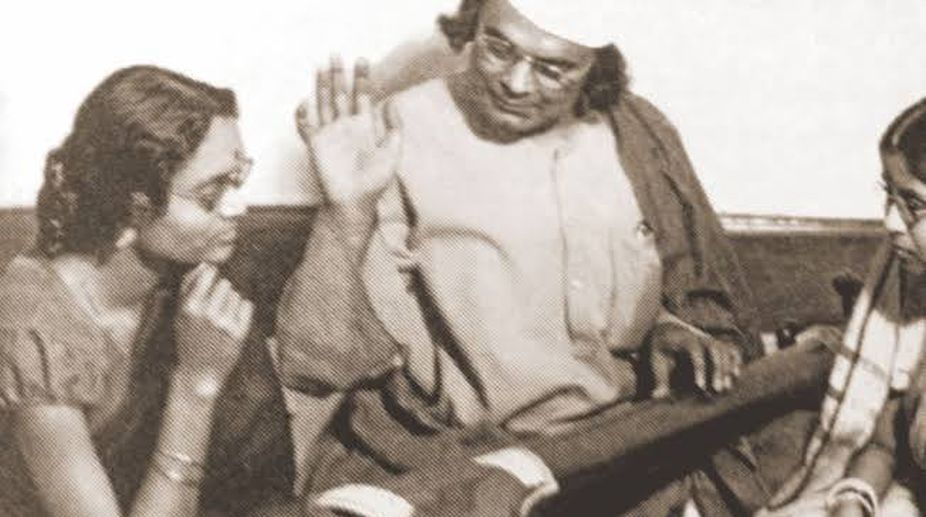Kazi Nazrul’s visionary pen
The year 2024 marked the 125th birth anniversary of poet, songwriter, music composer, singer, novelist, essayist and journalist Kazi Nazrul Islam (24 May 1899 – 29 August 1976).

Kazi Nazrul Islam (R) (Photo: Facebook)
Chhayanat (Kolkata) recently organised “Nazrul Mela 2017”, a mega event including musicals at Sisir Mancha, seminar on the life and works of Kazi Nazrul Islam at Abanindra Sabhagriha and photo/statuette/philately exhibition at Gaganendra Shilpa Pradarshasala. Artistes and admirers of Kazi Nazrul Islam from both West Bengal and Bangladesh collaborated to make it a success. Legendary Nazrulgeeti singer Ferdous Ara (Bangladesh), Indranil Sen and several other dignitaries inaugurated it. While a host of eminent singers including Chandrabali Rudra Dutta, Ramaanuj Dasgupta, Susmita Goswami, Anusua Mukhopadhyay, and groups like Chhayanat, Bageshree, Kathashilpi, Geetolekha, Bisher Banshi, Amodini (India), Surosaptak, Ranota, and Banshori (Bangladesh) offered melodic and literary tributes to Nazrul through his unmatched oeuvres, Sayed Hashmat Jalal, Binod Ghosal, Kalyani Kazi, Mujibar Rahman (India), Masum Chowdhury and Kamaluddin (Bangladesh) participated in the seminar.
The exhibition included some paintings of Nazrul byTarak Garai and Wasim Kapur and “Autograph on Photograph” that displayed exclusive photos of renowned Nazrulgeeti singers of both the countries from the enviable collection of photographer Prashant Arora. He also displayed his collection of relevant and rare stamps published by the governments of India and Bangladesh. There were two very rare stamps dated 1968, published by the then East Pakistan government in honour of Nazrul. On the occasion of 90 years of Bidrohi Kobita(2011), Bangladesh Government issued a commemorative coin. Although the face value of this is only 10 taka but it is made of 25 grams of pure silver by Dutch Bank.
Advertisement
This took a pride of place in the articles displayed by Arora, who is a wellknown philatelist as well. There was also a display counter that showcased music CDs, books, stamps, manuscripts and publications based on Kazi Nazrul Islam (25 May 1899 – 29 August 1976). All this unplugged the painful lifestory of a genius who, despite his indomitable spirits, had to spend more than three decades of his life in silence.
Advertisement
Since 1942, when he was barely 43 and at the peak of his creativity, he began to suffer from an unknown disease, losing his voice and memory. It was rumoured that the British Government had slowpoisoned him but later it was diagnosed as a rare and incurable neurodegenerative disease. And yet Nazrul is still remembered as Vidrohi Kavi, a fiery rebel poet who raised his voice against injustice in every sphere of life. Much later, his power-packed writings and compositions became a great source of inspiration for the rebels who led the Bangladesh Liberation War in 1971. As such Nazrul is hailed as the National Poet of Bangladesh.
Beautiful blend
A packed Rabindra Sadan saw a delightful dance drama with a unique Odissi composition based on Bengal’sPadavali Kirtan, presented by Kolkata Mayur Lalit Dance Academy on the occasion of its 15th annual day. Titled Balya Leela, it began with a Krishna Vandana and then portrayed the story of little Krishna (Gopal) and Balaram playing with other Gopa-baalak of Vrindavan and enjoying the stolen butter (Noni-chori). Then they all went to the forest with the cows. This Goshtha leela, with imaginative dance compositions depicting little boys having fun with the cows, was very convincingly presented by the young dancers. Debamitra Sengupta, as Yashoda stole the show with her very distinctive abhinaya skills, beautifully portraying the Mother’s love (vatsalya) for Krishna. The role of Rohini was very aptly played by Snigdha Sengupta. Little Gopal (Prishni Panda) and Balaram (Hrishita Kesh) were much appreciated in their very spontaneous and natural pranks. All other Gopinis and Vaishnavis performed with equal élan within the well-knit, neatly choreographed storyline. Soulful rendition of kirtan by Seema Acharya Choudhury with Shrikhol by Goutam Bhattacharya and exquisite light design by Dinesh Poddar added life to the production.
Earlier, the evening started with a very colourful presentation by the beginners' group of Mayur Lalit, who performed on a shloka invoking blessings of Goddess Meenakshi, followed by Batu and a Shivastuti. Then the intermediate group presentedShankavaranam Pallavi, set to ekataali. The Odissi repertoire ended with an electrifying performance of Chandi by the senior trio of Nayanika Sengupta, Aishee Ganguly and Esha Sengupta. This was followed by felicitations of the distinguished guests including Alokananda Roy, Debasish Kumar (member, Mayor-in-Council), Jui Biswas (councillor) and several others. The entire show was conceptualised and choreographed by Debamitra Sengupta, a renowned Odissi danseuse, guru and lifeline of Mayur Lalit.
Advertisement